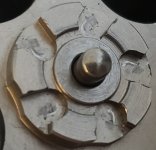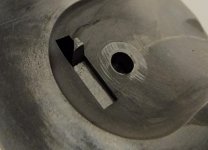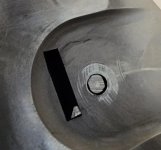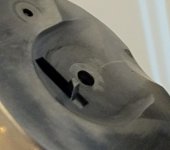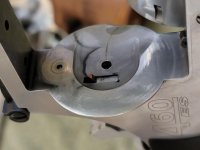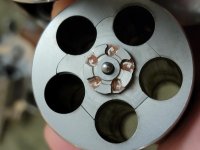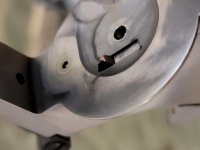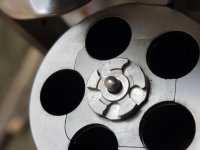I marked the ratchet with a paint pen on the lands. I dressed the hand very minimally with a very fine stone to help the rubbing concern. While it is better, the concern is still there. I've included pictures of the ratchet so the problem would be clearly visible. No effect was observed on timing. I was dressing the lower portion of the hand as the permanent marker was being rubbing off the bottom of the hand. When I say lower portion I'm referring to side of the hand opposite of what first engages the ratchet. Should I let what's taking place take its course or have it addressed in a more in depth manner? I've also included the wear pattern the hand is producing on the ratchet with a paint pen.
Just FYI: while you did no harm, the lower portion of the hand that you dressed has no affect on the issue, except your getting hand nose contact on the ratchet that you show in the photos. And that's why you got no change in the binding. It's the opposite edge at the top of the hand that is making the hand bind against the ratchet.
The surface of the ratchet that you painted and that shows the hand contact are really not relevant or important to the binding issue however. It's the upper vertical curved surface of each ratchet that the uppermost top front edge of the hand contacts that can cause binding.
Once the cyl locks any particular chamber into battery, if the hammer still needs to travel slightly further to fully cock by engaging the trigger sear, that's when the binding occurs. Because further travel of the hammer is also advancing the hand further upwards.
Also the top surface of the hand is flat, not curved like the vertical ratchet surface. Look carefully at the top corners of the hand for wear. Those are the contact points to the ratchet vertical surface. Slightly rounding those sharp corners (mostly the right side corner) to match the shape of the ratchet curve will affect the binding and also reduce friction. If then you still feel binding, the hand is just a smidgen too tall.
In a perfect world the cyl stop will lock into the cyl notch at the exact same time the hammer notch and trigger sear engage.
When the lock up of ratchet notch and cyl stop lag behind the hammer - trigger engagement, the timing is behind which is called a "carry up" problem. This is caused by worn ratchet teeth (usually) and/or a worn hand (too short).
When the lock up of ratchet notch with cyl stop precedes the hammer - trigger engagement, you have 'over travel'. That causes binding. This can be caused by worn hammer/trigger engagement, but not on a new gun like yours. Unless the hammer notch/trigger sear are miss-cut which is highly unlikely in a S&W. So that leaves a hand that is slightly too tall. Obviously this is safer than a carry up problem. And perhaps S&W builds this into their guns to allow the parts to wear in a slight bit until the sharp corners are worn off the parts and still not cause a carry up issue after the couple of thousand rounds. Note that the hand is harder steel than the notches because in a 5 shot cyl like yours, the hand gets 5 times the wear of each ratchet notch. But being the softer steel of the two, the ratchets are what will wear in more than the hand. To remain competitive with the price of their guns, extra final fitting of parts is too costly and borders on a custom tuned action.
On my guns I don't mind putting in a little stoning time on those 'sharp edges' to fine tune them right out of the box. You can do nothing and the gun will be fine and get better with use. You sound like me however, but it's your gun and your decision of course.
I hope you find this helpful for explaining what's going on,

